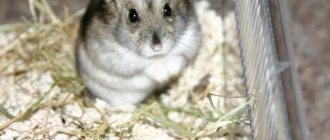/ Hamsters / Do hamsters hibernate at home?
0
2899
Article rating
The winter period affects each animal differently. For some, activity decreases during this time, while others even fall into deep hibernation. This is why not all people know whether hamsters hibernate.
Hamsters hibernating at home
Video: the hamster hibernated
How long do hamsters sleep and do they hibernate?
Why do hamsters chew their cage?
Why do hamsters love to run on a wheel?
In their natural habitat, hamsters are crepuscular - they are most active in low light conditions at sunset or dawn. Thus, following its nature, your pet hamster will sleep during the day when you are awake. If you want to play with your pet, you will first have to wake him up. Luckily, there are several ways you can wake up your fur baby without scaring him. It is best if you start waking your hamster as close to the time he usually wakes up (that is, closer to dusk). Try not to interrupt your pet's deep sleep or disturb him in the middle of the day.
Habitual sleep pattern
At its core, the hamster is a nocturnal animal, both at home and in nature. At night he is awake, and during the day he sleeps.
An animal can easily sleep all day, but when night comes, he will begin to actively spin the wheel, climb in mazes and restore order in the cage. Many owners of a cute animal are not happy with this, so they try to teach it to sleep at night.
This is very difficult to do. In addition, if the owner does not allow the pet to sleep during the day, this will unsettle him. Therefore, it is better not to interfere with his usual sleep pattern.
The rhythm of life of wild animals
Once again, to understand the life cycles of hamsters, let's turn to the wild. All new owners are concerned about the question: do hamsters hibernate? And what kind of life do they generally lead?
Hibernation
The rhythm of life of wild rodents is quite simple: in the warm season, crunchies fill their cheeks and carry reserves in them to their burrow. They are preparing for unfavorable conditions - lower temperatures and lack of food in the meadows and vegetable gardens.
When the average daily temperature outside drops and the day becomes very short, the homa understands that it is time to get some sleep. After all, maintaining body temperature at a constant level during cold weather requires a large amount of food. But the hamster is an economical animal. If he eats up his reserves while trying to stay awake, he won’t survive the winter. Therefore, the homa goes into a hole, makes a nest of dry leaves and falls asleep not far from the pantry.
A sleeping hamster begins to breathe less frequently, its heartbeat also slows down, and its metabolism seems to adjust to an economical mode. At the same time, his body temperature becomes lower by 1-2ºС, which also saves energy resources for heating. The body is nourished during hibernation by the fat layer that the crunch has gained over the summer. Periodically, the homa wakes up, snacks on supplies and falls into torpor again.
With the spring temperature rise, rodents come out of their stupor and continue to eat up reserves, because there are still a couple of months before fresh food ripens.
Daytime nap
People don't often see hamsters in the wild because they are nocturnal animals. Khoma has no time to sleep at night, because under the cover of darkness he obtains supplies. Darkness is his faithful protector from predators and gardeners trying to catch the animal.
Tired during a working night, after dawn the homa hides in its hole, has a snack and goes to bed until the next evening. Likewise, the domestic hamster sleeps when people are active, and wakes up in the evening.
Is it worth waking up?
Hamster breeders do not give a clear answer to this question. You will have to make a decision yourself, based on the data presented below.
Not worth it
On the one hand, in nature, a hamster approaches hibernation consciously and with full responsibility. He conscientiously eats up the subcutaneous fat layer so that he has something to eat in his sleep.
And there is an opinion that if the hamster is not woken up, unprepared - not well fed - he may simply die in his sleep. But in nature, when he gets hungry, he wakes up and “stomps into his pantry to inspect the supplies”! What's stopping him from doing this in a cage?!
How long do hamsters sleep and do they hibernate?
Nature is very wise, so she made sure that it was easier for animals to survive the winter.
For example, bears hibernate, this allows the body to expend energy sparingly, the animal’s life processes slow down, and subcutaneous fat is deposited.
Many hamster breeders are interested in the question of whether hamsters hibernate and how long they sleep. Under natural conditions, the rodent hibernates, but it happens in a lighter version.
What is numbness?
The hamster's body is not adapted to bear-type hibernation; a condition characteristic of rodents is called torpor, which happens in winter. The difference between typical hibernation is the duration.
Torpor is a short-term hibernation, during which all processes in the little playful’s body slow down, the body temperature drops, he does not react to anything, he “freezes.”
These processes are affected by lower air temperatures and day length. In spring, the days become longer, it is warmer outside and rodents stop becoming stiff.
Pet hamsters can also become torpid. Don’t be alarmed if one morning you see that your pet makes no noise and shows virtually no signs of life. We hasten to reassure you, most likely he is alive. Take the baby in your arms, warm him up, stroke him tenderly and life will return to him.
Hamster torpor is a kind of “standby mode”, during which the rodent does not react to external stimuli; outwardly it looks as if it is sleeping.
Causes of torpor in pet hamsters:
- low temperature in the apartment, not comfortable for the hamster;
- lack of food and poor nutrition;
- insufficient lighting.
Despite their fur coat, the animals do not tolerate hunger well, because hamsters originally lived in the steppes. If you take care of a balanced diet, put a heating pad under the cage or place a small heater nearby, it will not become numb.
A sleeping hamster quickly comes out of this state under comfortable conditions. After hibernation, the rodent needs to be fed soft food, for example, unsalted oatmeal, boiled vegetables.
At home, it is very important to provide your pet with a sufficient amount of daylight and to feed it well. Hamsters are small animals, but they require a lot of attention and a lot of love.
If you provide your pet with care, he will not need to hibernate
Hamsters are small animals, but they require a lot of attention and a lot of love. If you provide your pet with care, he will not need to hibernate.
If a sleeping hamster has not prepared for hibernation, has not eaten enough fat, and has fallen into an “emergency torpor” in order to avoid exhaustion and dehydration, it is still worth waking him up. By such actions you will not harm the baby, but you yourself will be calm and save him from starvation.
To force the hamster to come out of hibernation, owners resort to tricks. For example, they wrap the cells in a warm blanket, rags and add treats.
Interestingly, Syrian hamsters are more susceptible to hibernation; Dzungarian hamsters fall into torpor for several hours. In this state, the hamster can endure a lack of food, uncomfortable temperatures and other unfavorable conditions.
A dwarf hamster or another breed of hamster can remain in a state of torpor for several hours or even days - it all depends on external factors and the comfort of the animal’s standard of living. In the wild, in order to become numb, a hamster only needs to come out of its own burrow on a late winter evening. If a baby spends the whole day in an uncomfortable, low temperature, his body will begin to “save energy.”
If you decide to wake up your hamster, under no circumstances should you place it on radiators, heaters, or place the cage near an open fire. Dry, soft warmth and the ability to warm up gradually are more valuable.
We have already figured out why the hamster sleeps, but how can we understand that he has come out of his state of torpor? The animal will begin to breathe more often, tremble, and move independently.
Hamsters are nocturnal animals, so they are awake at night and sleep during the day. It’s difficult to say how much hamsters sleep, because it varies from person to person. An animal can easily sleep all day and be active at night: spin a wheel, climb in labyrinths. Some owners are not satisfied with this state of affairs, and they want to wean the rodent from sleeping during daylight hours.
It is difficult to train a hamster to walk during the day and sleep at night, even if you remove the wheel at night, wake the animal during the day to clean the cage and slip in some goodies. If you constantly prevent your hamster from sleeping when he wants it, it will unsettle him. Let your pet set his own routine, unless you really want to play with him.
Hibernation or torpor
Coming home one day, you may see that your hamster shows no signs of life. You take it in your hand and feel that your pet is cold and almost numb. Do not rush to declare the death of your pet. This may be precisely this protective reaction of the body. Check for heartbeat and breathing. It will be very slow, but it will happen. If the heart is beating and the rodent is breathing, it means that it has fallen into torpor or hibernation. We need to get him out of this state and improve the comfort of his life. As a rule, Syrian hamsters fall asleep longer than Djungarians.
The difference between hibernation and torpor is time. In the first version, this is a long sleep, lasting from several weeks to several months. The animal can wake up to eat. And in the second option, this is a short-term period that lasts from several hours to several days.
Is there any point in waking him up?
Knowing now how a hamster hibernates and for what reasons, the next question immediately arises: what to do in such a situation and whether it is necessary to push the animal so that it comes to its senses. Experts recommend that if a rodent has fallen into torpor before winter and has not gained any fat before that, then the rodent must be awakened, since then it will die from exhaustion and dehydration.
But, if everything is fine, and you see this in your animal, and he has gained fat, it is better not to touch him, he will wake up on his own.
How to wake up a hamster
Once you realize that your pet is in a state of torpor, in order to wake him up, he must be placed in a warm place. Under no circumstances should you place your hamster near a fire, on a radiator, or on a heater.
One of the best ways is to hold the rodent in your arms and breathe on it, thus warming it up. Slowly the animal will tremble and move, and after 30-60 minutes the hamster will come to its senses.
THE HAMster DIDN'T DIED HOW HAMsterS Hibernate Torpor | Elli Di Pets
Waking up a hamster from hibernation????????????????????????
WHY DID THE SEED FALL IN Hibernation? / HOW TO SAVE HER? / DO HAMKS REALLY Hibernate? / ALICE EASY
What else should you expect?
At first, your hamster will be lethargic. He will likely be lying on his stomach with his limbs extended. The more he wakes up, the more active his movements will be. The first sign of waking up is twitching of the eyes and whiskers. Then he will be able to raise his head, but not for long.
Then, when the hamster can hold his head up, he will make an attempt to sit down and begin to walk, slowly, swaying from side to side until he eventually gains control of his body. He will shiver a little for a while, but this is quite normal as his body temperature rises to normal and his muscle tissue begins to contract.
It may take more than three hours for your hamster to wake up, and during this time continue to warm, rub, water and feed him. You don't have to worry, the hamster will soon come to his senses and be the same as before. If within the first hour you do not find any improvement in your hamster’s condition, immediately contact an emergency veterinary service.
Recommended sequence of actions and process features
So, in addition to running water, soda and citric acid, we will need a thin brush or a strong fishing line with a soft, lint-free rag. If you follow all the recommendations correctly, the desired result can be achieved without much hassle in a quarter of an hour. To clean the hookah, you must perform the following manipulations:
- Remove the foil from the hookah bowl and remove all remaining tobacco mixture. It is best to use a soft brush or cloth for this.
- We disassemble the structure into its component parts as much as possible, pour out all the liquid from it.
- Next, we assemble the device again, attach its mouthpiece to the water tap and let in the liquid. We make sure that the water flows in the direction opposite to the movement of smoke while smoking a hookah.
- Next, we replace the mouthpiece with the upper part of the shaft and continue the process, but now in the opposite direction. The stage using clean running water should last at least 8-10 minutes. We remember that, if possible, the liquid should be as hot as possible (if the material of the elements allows it).
Mine cleaning
- Next, we disassemble the hookah again, now we need to clean all its parts separately.
- First we are working on the hose, for which we will need a very thin brush with soft bristles and a long handle. If you use a regular brush, you can damage the rubber. The use of wire can also cause damage to the material in case of careless movements. It is best to use a profile device or wire securely wrapped in rags. We move the device back and forth for a couple of minutes, if necessary, changing the fabric or washing the bristles of the brush. You need to blow out the hose or rinse it several times to finally get rid of dirt and deposits.
Cleaning the hose
Next, we begin to process the bowl using a clean cloth and household chemicals. First, prepare a solution of weak concentration, pour it into a bowl, leave for a couple of minutes, drain and clean with a cloth soaked in the same composition. If necessary, repeat this several times or increase the concentration of active substances. Next, be sure to rinse everything with clean water.
Cleaning the flask
After the cleaning procedure is completed, you must use a clean, soft and dry cloth to remove excess moisture from all accessible surfaces of the hookah parts. If this is not done, they will gradually oxidize and become unusable.
Today, specialty stores offer specialized hookah cleaning products. From a practical point of view, they are very convenient, they thoroughly wash away dirt and do not leave behind an unnecessary aromatic trail. True, they cost a lot, are consumed quite actively, and their shelf life expires a few weeks after the first use. Therefore, if the hookah is not used very often, it is better to limit yourself to using familiar household chemicals.
We suggest you familiarize yourself with the shape of napkins for the table
Why does a hamster become torpid?
You and I know that it is common for many animals to fall into a state of torpor during the winter. This makes it easier for them to tolerate low temperatures and lack of food. In a state of hibernation, metabolic processes in the animal's body slow down, the body saves energy. At the same time, breathing and blood circulation can be heard, although it is reduced.
If a domestic hamster, whether a dwarf or a Syrian, finds itself in similar conditions - it does not have enough food, it is kept in conditions that are not comfortable for it, it can fall into a state of torpor. But if the room is warm, the rodent has food in the feeder, and the owner finds the lifeless body of his pet, there is very little chance that he suddenly decided to hibernate
Rather, death came. And there may be many reasons why this happened. Errors in care, improper diet, illness, injury... There is always something that can explain the condition of the rodent.
Sleeping or dead?
This is not difficult to determine. The main thing is to be patient.
- In a state of torpor, the hamster’s body, although cold, hard and motionless, can still hear its heartbeat. It is rare - only a few beats per minute.
- The animal also occasionally continues to inhale and exhale. Hold a mirror to its muzzle: if the hamster is alive, after some time traces of fogging will appear on the glass from its breathing.
Do pet hamsters hibernate?
Slonvartire.ru / Hamsters / Do hamsters hibernate at home
2333
articles
The winter period affects each animal differently. For some, activity decreases during this time, while others even fall into deep hibernation. This is why not all people know whether hamsters hibernate.
Hamsters hibernating at home
Do hamsters hibernate?
Many people wonder whether popular pets like hamsters hibernate, and if so, what should be done in such a situation. Temperature and its changes, the length of daylight - all these factors still affect the life of a hamster, even if he is in a cage.
Therefore, it is quite logical that we can assume that hamsters hibernate, but instead of sleeping for the entire winter period, three months, they enter a state of torpor for some time.
Hamsters hibernate, but unlike wild ones, domestic ones have their own period of torpor. They enter a sort of comatose state for a while, usually this lasts several days; sometimes there have been cases where hamsters do not come to their senses within a week.
State of numbness
Torpor is an alternative state to hibernation in an animal. This condition is very easy to recognize. All processes in the animal’s body begin to work much slower.
Experts compare this state to how an animal would be in standby mode. It looks as if the animal has died.
His body becomes numb, and the rodent does not respond to any external or internal stimuli.
Unfortunately, very often there are cases when the owners mistook this state of their animal for death, and as a result, they themselves doomed it.
Causes of numbness
There are many reasons for hibernation
If everything is clear with natural conditions: winter has come, and the animal has fallen into such a state, then the big question arises, how does this happen at home? Many factors influence a pet's torpor.
- Temperature difference. If you don’t want to find your pet lying on its back one morning, not reacting to anything, then at the moment when the cold sets in and the apartment is not heated, you need to warm the hamster so that there is no sudden temperature change.
- Also, different things happen in life: they got stuck, there was no time all day, or many other factors, and for some reason the hamster is not given anything to eat. But that’s what rodents are for, they are rodents, to constantly gnaw on something. Therefore, as soon as an animal believes that it does not have enough food to save its life, it goes into a “trance”.
- In addition, we must not forget about vitamins and useful minerals. If for some reason the rodent does not receive them, then it also suffers greatly. His activity automatically decreases, he stops running and moving. The body thinks that something is happening inside the animal itself, so in order to wait out a bad period in its life, it goes into a “trance”.
- And one of the big problems is poor lighting. All rodents are from warm countries, so sun and light are very important for them. Therefore, if for some reason the rodent decides that there is not enough light for it, then the body, at the instinctive level, believes that winter has come and it’s time to sleep. Therefore, rodents must have their own lamp.
It is these criteria that have a great influence on the life of a rodent. Therefore, so that one morning you do not see your pet in a strange state, all these four points should be adhered to. Much depends on the conditions of detention.
How to wake up a hamster
Once you realize that your pet is in a state of torpor, in order to wake him up, he must be placed in a warm place. Under no circumstances should you place your hamster near a fire, on a radiator, or on a heater.
One of the best ways is to hold the rodent in your arms and breathe on it, thus warming it up. Slowly the animal will tremble and move, and after 30-60 minutes the hamster will come to its senses.
THE HAMster DIDN'T DIED HOW HAMsterS Hibernate Torpor | Elli Di Pets
Waking up a hamster from hibernation????????????????????????
WHY DID THE SEED FALL IN Hibernation? / HOW TO SAVE HER? / DO HAMKS REALLY Hibernate? / ALICE EASY
Conclusion
Hamsters don’t experience such torpor; they just fall asleep for a while. The most important thing is not to confuse this moment with the death of an animal. It is not necessary for pet rodents to go into torpor. Dzhungarika torpor most often appears in winter, and much depends on the conditions of their detention. Most often, domestic animals do not have this state of torpor.
State of numbness
Torpor is an alternative state to hibernation in an animal. This condition is very easy to recognize. All processes in the animal’s body begin to work much slower. Experts compare this state to how an animal would be in standby mode. It looks as if the animal has died. His body becomes numb, and the rodent does not respond to any external or internal stimuli.
That is why experts strongly recommend that if you think your animal has died and is not responding to anything, do not consider burying it in the backyard. The first thing you should do is check the animal for breathing, it may be weak and barely noticeable.
Unfortunately, very often there are cases when the owners mistook this state of their animal for death, and as a result, they themselves doomed it.
Duration
Also, despite the fact that hibernation should take place in winter, this can also be observed in domestic rodents in other seasons. The animal may have barely noticeable breathing, which again can lead to a false conclusion. But, the heartbeat will always persist, so don’t be lazy to check it. Bring the animal to your ear, but if you don’t want to do this, then just leave the hamster in the cage and wait.
After a few days or weeks, the animal will recover from its stupor and come to its senses. People often wonder whether Djungarian hamsters hibernate. In fact, ordinary hamsters are no different from dzhurngarsky hamsters, but in dwarf rodents “hibernation” occurs a little less. It usually lasts a couple of days, maximum 5 days.
Hibernation in hamsters: how often does it happen and is it worth waking up?
Hamsters have been bred at home for many decades. These nimble, funny animals have retained the genetic memory of their wild ancestors. Under certain conditions, just like their freedom-loving relatives, they can be in a state similar to hibernation. How to understand that a hamster is hibernating, how dangerous is it and what to do?
What is torpor and hibernation?
Torpor in hamsters differs from the hibernation of its wild counterparts primarily in the reason that caused this condition. Hibernation among wild brethren is a natural protective reaction of the body to harsh winter conditions.
In pets, the instinct of self-preservation is also triggered, which is expressed in numbness. This is an alternative state to rodent hibernation. It is not difficult to recognize him.
Life processes in the hamster’s body begin to work at a slow pace.
A zoologist compares this phenomenon to the fact that this is a kind of defensive reaction of an animal, a “standby mode” in order to more easily survive some unfavorable moment.
From the outside it looks very much like the animal has died. The body becomes cold, the muscles are “linked”, the hamster does not react to external stimuli.
Seeing your pet in this form, you shouldn’t be scared or make hasty conclusions, but carefully check: is he breathing, is his heart beating? To determine that a Syrian hamster is hibernating, you need to be patient. The heart makes only 4 beats per minute. You can hear this by bringing the animal close to your ear. Breathing is also weak and almost imperceptible.
What causes hibernation at home?
What is normal for wild hamsters is not always good for pets. There must be good reasons for a dwarf hamster or another representative of domestic hamsters to hibernate. And they are usually unfavorable:
- The cold in a house or apartment provokes a state of suspended animation. When the temperature in the room where the pet is located stays at 15 degrees for a long time or drops below, there is a very high probability that the animal will hibernate. At 10℃ this is inevitable.
- The animal associates darkness with the onset of winter. Staying in the sun is also harmful for the animal, but the curtains in the room must be opened in the morning so as not to shorten the daylight hours. Otherwise, it will mean autumn for the hamster.
- Improper nutrition with insufficient amounts of vitamins and microelements results in lethargy of the rodent. A constantly sleepy or sleeping hamster is a “bell” that not everything is normal. If the hamster is not provided with adequate food, its body will react with suspended animation.
- Stress often causes hibernation. Numbness helps the animal cope with the excitement it has experienced. Stress is, first of all, the fear experienced when a cat or dog appears next to a cage, the cage falls, or a very loud, sharp, unexpected sound.
It happened that the animal fell into a state of suspended animation after a long journey. Moreover, this can happen to an animal at any time of the year.
Should I wake you up or not?
When it becomes clear that the pet is in a daze, there is no need to immediately bother him or try to wake him up. First you need to understand the reasons for hibernation.
The reason that could be is the cold. However, under natural conditions, hamsters approach the cold period prepared - they have an “extra” layer of fat from which they feed. A pet can die in its sleep from exhaustion. You need to wake him up, but first adjust the temperature in the room.
To wake a hamster from hibernation, you need to pick it up and warm it with your palms and breath. This will take about an hour. If you don’t have time to warm your baby in your palms, under no circumstances should you resort to using heaters and lamps. The animal will die from intense heating.
If the cause of torpor is stress, the hamster should be woken up after 24 hours. During this time he will have time to come to his senses. They wake him up in the same way - by enclosing him in their palms and stroking him.
You need to put “sweets” in the feeder so that the pet becomes interested in them, and he loses the desire to hibernate again.
What to do with a hamster in a state of suspended animation
If a pet rodent goes into hibernation, owners have two options - wake it up or do nothing. You should choose based on the physical characteristics of the hamster and the causes of suspended animation.
It is imperative to wake up a hamster that has fallen into a state of suspended animation due to the cold (especially if it is small). Otherwise, he will most likely die from exhaustion. To do this, the baby needs to be warmed, but only with his own heat, without using lamps or heaters.
Take your pet in your hands and stroke it. After an hour, you will notice that his temperature has risen and his heart rate has increased. When the muscles begin to contract, you will understand that he is coming to his senses.
If the cause of torpor is stress, do not wake the hamster right away - let him sleep for a day.
Why does a hamster sleep constantly (all day and night)
It is also possible that the duration of sleep increases up to 20–22 hours. This can happen due to several reasons, some of which are due to environmental conditions, and some of which are due to the condition of the hamster itself.
Here is a list of the most likely reasons leading to a significant increase in the sleep duration of these animals:
the pet you purchased is too old (more than 1–1.5 years old); the animal is exposed to excessive stress, for example, due to constantly pestering children or due to excessive interest in it from other pets; the animal eats irregularly, in insufficient quantities, or its diet has a pronounced imbalance of the protein-energy component; there is not enough light in the room in which the animal’s cage is located, but it must be remembered that the presence of not direct, but rather diffuse, sunlight is important; the room has a constantly low temperature, which significantly slows down the metabolic processes occurring in the animal’s body and, accordingly, increases the duration of its sleep; The hamster's cage is not properly equipped: first of all, we are talking about the lack of a variety of toys, labyrinths and wheels that allow these animals to receive the necessary boost of energy during intense physical exercise.
How to wake up a hamster?
To awaken the hamster, it is necessary to create conditions opposite to those that caused the rodent to go into torpor. The cage needs to be moved to a warmer and brighter place, where the air temperature will not be lower than 20-22 degrees Celsius.
You can put his favorite treats next to the spout, wrap it in a warm cloth and put more food in the bowl.
After waking up, the animal will not be active. At first he will be very lethargic. It is necessary to wait until all its life processes resume.
It is prohibited to warm up a rodent using radiators or electric heaters. This may harm him or lead to death.
Walk
When you see a hamster gnawing doomedly at the bars of its cage, does your heart clench with pity? Do you feel that your hamster needs freedom, so every evening you let him out for a walk and watch with affection as he gets stuck under the closet or falls from the curtain? Whether or not to let your hamster out for a walk is up to you, but the best thing you can do is buy a ball for walking or fence off a safe area with enclosures. Believe me, there is no hole that a hamster cannot fit through. Although it seems to you that your pet is a fat, overfed hog, in fact, at the right time he can become very flat, so it is better not to let him roam freely. Otherwise, you risk finding it on the cabinet, in a pot of fish, or, God forbid, in your underwear drawer. Yes, a hamster can do it.
Sleep standards
For a comfortable rest, the sleep norm is 6–10 hours a day. Nature has carefully thought out everything, so hamsters sleep during the day and are awake at night.
Djungarian hamsters, which are most often kept as pets, can go to bed at 8 am, or even at 10 am. Each individual chooses a comfortable rest time. Some sleepyheads can sleep 14 hours a day. You shouldn’t be surprised by this behavior, because everyone has their own body and needs.
Reference. As a result of the stress they have suffered, some rodents can sleep 20 hours a day, this is how they regain strength.
Hamsters, just like people, are highly dependent on changes in their lives. For example, when moving, they also get unnecessarily tired. There are two main lines of behavior for a pet when moving to a new place of residence:
- Active state. In this case, the pet studies everything that surrounds it, runs and frolics. He tries to study everything and make it as comfortable as possible for himself, in which case he has very little time left for sleep, about 3–5 hours a day.
- Dream. The animal constantly tries to hide from prying eyes, leaving the house only when it wants to eat or go to the toilet. The pet sleeps for almost 20 hours a day; getting used to it can take up to one week.
This reaction of a rodent to stress is completely normal and the owner has no reason to worry.
Important. You should not try to retrain your pet to be awake during the day. Most likely, you won’t succeed, but the harm to your pet’s health can be significant.











